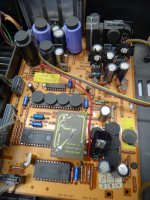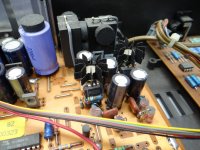I just got a very collectable Philips CD650 CD player.
I opened it up and someone put a whole lot of what what seem like foam rubber disks on IC's capacitors and the board itself. I have looked at other pictures of this model and these disks are not there. I have never seen disks like this before.
My question is what purpose could they possibly serve (and what are they )????
I opened it up and someone put a whole lot of what what seem like foam rubber disks on IC's capacitors and the board itself. I have looked at other pictures of this model and these disks are not there. I have never seen disks like this before.
My question is what purpose could they possibly serve (and what are they )????
Attachments
The previous owner (rightly or wrongly) has been trying to damp vibrations of the components to which the disks are attached.
very good answer ! I get the feeling some other changes might have also been made, the player works and sounds fine at least.The previous owner (rightly or wrongly) has been trying to damp vibrations of the components to which the disks are attached.
I personally do not see how they can helpHere's what they probably are: https://www.vital-parts.co.uk/self-adhesive-rubber-pads-10640-p.asp
Well, at least they can do no harm - apart from maybe leaving a sticky residue if you try to remove them!I personally do not see how they can help
whoever did that also did some incredibly complex miniature upgrades to the OP amps in addition to some other mods I need to research
those heat sinks are on top of several components and then plugged into the new op amp sockets
I do not know yet what the two black towers behind them are
those heat sinks are on top of several components and then plugged into the new op amp sockets
I do not know yet what the two black towers behind them are
Attachments
Most of the information on this model is for the Magnavox version sold in this country as the model 650, I am digging deep to get answers, there are lots of mods for this model
One of the many nonsense ideas floating around is that capacitors/resistors/transistors/ICs "vibrate" and that hugely affects Sound 🙄
Consequently,many non-solutions have been offered for this non-problem.
One of them included some kind of repurposed Mom´s nail enamel or similar, claiming a beneficial Sound effect, go figure.

Those unnecessary foam pads may be supposed to be the same.
Like Enzo often says:"take two placebos, they work twice as well" 😊😊😊
PS: for those brave enough, I copypaste some of the BS accompanying that little enamel bottle:
https://steinmusic.com/project/maestro-laquer-cd-plus-ccs/
Consequently,many non-solutions have been offered for this non-problem.
One of them included some kind of repurposed Mom´s nail enamel or similar, claiming a beneficial Sound effect, go figure.
Those unnecessary foam pads may be supposed to be the same.
Like Enzo often says:"take two placebos, they work twice as well" 😊😊😊
PS: for those brave enough, I copypaste some of the BS accompanying that little enamel bottle:
Maestro Lacquer
Maestro Lacquer
Maestro lacquer is a natural resin lacquer with very special properties, optimized for coating loudspeaker cones and electronic devices for music reproduction. Mechanical resonances of any body are reflected at its interfaces. If you change the top layer by applying Maestro varnish, it is able to imprint its sound character on the coated part. Please note the fundamental difference to concepts that aim to achieve a better sound by damping: With damping, you can reduce the amplitude of an unwanted resonance, but you also always change the quality of this resonance peak, which thus becomes wider. This in turn makes itself quite unpleasantly noticeable acoustically.
Basic Idea:
How does Maestro lacquer work? Internal resonances of a mechanical part come to its surface, and there will be reflected into the material again. By changing the properties of the surface we may influence the resonances in a big amount. Sound always has a certain character that we detect as nasty or pleasant. Breaking glass for example is nothing really attractive, but everybody will like the sound of a good violin.
https://steinmusic.com/project/maestro-laquer-cd-plus-ccs/
still trying to figure out what those 4 black components are
they have the shape of a power resistor
the ends look like epoxy
they have no markings
they are sets of 2 in parallel
they are where the capacitors should be, the standard mod at that spot is a pair of WIMA caps
they have the shape of a power resistor
the ends look like epoxy
they have no markings
they are sets of 2 in parallel
they are where the capacitors should be, the standard mod at that spot is a pair of WIMA caps
Last edited:
Perhaps they are simply foil capacitors that have been painted black - in an attempt to output a darker sound! 😉
Well actually adding weight to the top of the large capacitors could make them more likely to experience vibration fatigue as there's more mass to store resonant energy. Some silicone rubber goop around the base to support large components and damp resonances is a better fix for that...Well, at least they can do no harm - apart from maybe leaving a sticky residue if you try to remove them!
mmaghakian:
I suspect they're Marigo dots. Stereophile went berserk over them in the early '90s; the dots were described as made of multi-layer constrained energy-absorbing materials which, by converting unwanted vibrations into heat, would improve the sound of everything they were attached to. Marigo is still in business; see http://marigoaudio.com/z-dot-application/. In any event, I doubt they're doing any harm.
Check out Marigo's other products while you're at it; rather entertaining in my book.
Regards,
Scott
I suspect they're Marigo dots. Stereophile went berserk over them in the early '90s; the dots were described as made of multi-layer constrained energy-absorbing materials which, by converting unwanted vibrations into heat, would improve the sound of everything they were attached to. Marigo is still in business; see http://marigoaudio.com/z-dot-application/. In any event, I doubt they're doing any harm.
Check out Marigo's other products while you're at it; rather entertaining in my book.
Regards,
Scott
From a different point of view they are insulators and stop heat getting out so the parts will get hotter.The previous owner (rightly or wrongly) has been trying to damp vibrations of the components to which the disks are attached.
- Home
- Design & Build
- Parts
- What kind of a "mod" is this ? What are these things?????

